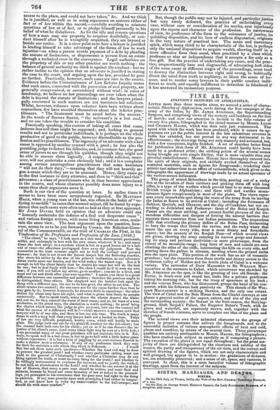FINE ARTS.
ATKINSON'S SKETCHES OF AFGHANISTAN.
Lrrima more than three months since, we noticed a series of charac- teristic Sketches of Afghanistan, made during the first campaign of the army of the Indus, by Mr. JAMES Arsmos, the Superintending
Surgeon, and comprising views of the scenery and incidents on the line of march; and now our attention is invited to the folio volume of
twenty-five plates, lithographed in the tinted manner by Messrs. Lours and CHARLES HAGHE, which was then only just commenced. The speed with which the work has been produced, while it causes its ap- pearance ere yet the public interest in the late calamitous reverses in India has subsided, has not proved in any way detrimental to its effectivenesss ; the drawings being not only masterly and animated, but, with a few exceptions, highly finished. A set of sketches better fitted for publication than these of Mr. ATKINSON could hardly have been made by a professed artist; the striking points of the several scenes being brought out with simple fidelity, that is more valuable than any pictorial embellishment: Messrs. HAGUE have thoroughly entered into the spirit of their originals, and skilfully availed themselves of the scattered materials, such as figures for foregrounds ; rendering their artistic tact subservient to an effect of verisimilitude, which gives to the lithographs the appearance of drawings made by an actual spectator of the various scenes delineated.
The group of armed Beloochees in the title, peering out of a rocky den at the invaders of their territory and picking them off with long rifles, is a type of the warfare which proved fatal to so many thousand British troops in Afghanistan ; and these wild and warlike moun- taineers figure conspicuously in most of the plates. The views repre- sent every remarkable spot along the route of the army from its leaving the Indus at Roree to its arrival at Cabal ; including the fortresses of Bukkur, Quettah, and Ghuznee, and the city of Candahar, but not ex- tending to Jellalabad and Peshawar: those of the Bolan and Koojah Passes are the most striking, and present fearful pictures of the tre- mendous difficulties and dangers of forcing the natural barriers that separate these countries from our Indian possessions. The stupendous cliffs that overhang the gloomy defiles of the Bolan Pass, threatening to bury the troops that thread the ravine, and the rocky waste that meets the eye on every side, wear a most dreary and formidable aspect; but the scenery of the Koojah Pass—of which several views are given, showing the army entering its narrow gorge and descend- ing its steep and perilous declivities—is more picturesque, from the extent of its mountain-range: long lines of men and camels are seen climbing the sides of the cliffs, intersecting the hills on every side, and pouring down the gullies in streams, meeting where the ground melts into the open plain. This portion of the work has an air of romantic grandeur; but the transition from these sterile and dreary scenes to the verdurous valley of Maidan and the fertile plain of Cabal is a welcome variety. The surrender of HOST MAHOMED to Sir WILLIAM MAC- NAGHTEN at the entrance to Cabal, which occurrence was sketched by Mr. ATKINSON on the spot, is like the greeting of two old friends : the Envoy, in frock-coat and round hat, looks like a private gentleman taking his morning ride, but for the troop of spearmen at his back ; and the veteran Dose, who has dismounted, grasps the hand of his con- queror, while his followers look passively on. This sketch of Sir Wu.- max MACNAGHTEN is a striking likeness, and the only one extant. The view of Cabal and the Bala Hissar from the Citadel conveys at one glance a general notion of the aspect, extent, and site of the city and the surrounding scenery : the Bazaar in the fruit-season the Burying- ground, Shah Soojah's Palace, the Emperor Baber's Tomb, with its grove and waterfall, are separately shown, and, together with the sketches of female costume, serve to complete our idea of the place and the people.
The several views owe their animated character to the groups of figures in proper costume that enliven the foregrounds, and to the imitation mitation of various atmospheric effects of heat and cold,
gloom and sunshine, by means of the neutral tints. These picturesque qualities are entirely attributable to Messrs. HAGEIE, the lithographers ; who have studied each subject as carefully as if composing a picture. The execution of the plates is not equal throughout ; but the great ma- jority of them are distinguished by the clearness and solidity of the masses, the purity and transparency of the air-tints, and the correct and spirited drawing of the figures, which are not only characteristic and well grouped, but appear to be in motion : the gradations of distance, too, are admirably preserved; and a sense of air, space, and vastness, is conveyed. In short, this is a most beautiful volume of lithographic drawings, apart from the interest of the subjects.


























 Previous page
Previous page